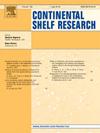渤海波流相互作用对水交换的影响
IF 2.2
3区 地球科学
Q2 OCEANOGRAPHY
引用次数: 0
摘要
渤海是典型的大陆架区域,其水交换能力一直是研究的热点。波流相互作用(WCI)作为大陆架水动力学的一个重要物理过程,对渤海水体交换的影响值得进一步研究。本研究基于FVCOM-UnSWAN波流耦合模型,采用保守示踪法讨论了WCI影响下渤海水体交换特性。进一步分析了季节变化和极端天气条件下WCI对水交换和水动力的影响。作为连接黄海和渤海的唯一通道,渤海海峡换水量的变化可以反映渤海的变化。针对这一区域,我们的研究结果表明,WCI调节水交换率:在冬季增加约1.3%的交换,而在夏季表现出复杂的行为,最初抑制,随后增加水交换。在风暴潮事件中,WCI在改变水动力条件方面起着至关重要的作用,使水位升高20% - 35%,与季节尺度相比,水流速度的变化要大一个数量级。在换水过程中,WCI通过引入非保守力Fw改变了水流速度结构,其中白盖耗散项起主导作用。本文章由计算机程序翻译,如有差异,请以英文原文为准。
Effects of wave-current interaction on water exchange in the Bohai Sea
The Bohai Sea is a typical continental shelf region, and its water exchange capacity has long been the focus of research. Wave-current interaction (WCI), as an important physical process for the continental shelf hydrodynamics, is worthy of further investigation due to its impact on water exchange in the Bohai Sea. In this study, based on the FVCOM-UnSWAN wave-current coupling model, the water exchange characteristics of the Bohai Sea under the influence of WCI were discussed using the conservative material tracer method. The effects of WCI on water exchange and hydrodynamics were further analyzed under both seasonal variations and extreme weather events. As the only channel connecting the Yellow Sea and the Bohai Sea, changes in the water exchange capacity of the Bohai Strait can reflect the change of the Bohai Sea. Focusing on this region, our results show that WCI modulates water exchange rates: enhancing exchange by approximately 1.3 % in winter, while exhibiting complex behavior in summer, initially suppressing and subsequently enhancing water exchange. During storm surge events, WCI plays a crucial role in modifying hydrodynamic conditions, increasing water elevation by 20 %–35 %, with changes in water velocity up to an order of magnitude larger compared to seasonal scales. During the water exchange process, WCI modifies the current velocity structure by introducing a non-conservative force Fw, among which the white-capping dissipation term plays a dominant role.
求助全文
通过发布文献求助,成功后即可免费获取论文全文。
去求助
来源期刊

Continental Shelf Research
地学-海洋学
CiteScore
4.30
自引率
4.30%
发文量
136
审稿时长
6.1 months
期刊介绍:
Continental Shelf Research publishes articles dealing with the biological, chemical, geological and physical oceanography of the shallow marine environment, from coastal and estuarine waters out to the shelf break. The continental shelf is a critical environment within the land-ocean continuum, and many processes, functions and problems in the continental shelf are driven by terrestrial inputs transported through the rivers and estuaries to the coastal and continental shelf areas. Manuscripts that deal with these topics must make a clear link to the continental shelf. Examples of research areas include:
Physical sedimentology and geomorphology
Geochemistry of the coastal ocean (inorganic and organic)
Marine environment and anthropogenic effects
Interaction of physical dynamics with natural and manmade shoreline features
Benthic, phytoplankton and zooplankton ecology
Coastal water and sediment quality, and ecosystem health
Benthic-pelagic coupling (physical and biogeochemical)
Interactions between physical dynamics (waves, currents, mixing, etc.) and biogeochemical cycles
Estuarine, coastal and shelf sea modelling and process studies.
 求助内容:
求助内容: 应助结果提醒方式:
应助结果提醒方式:


